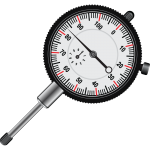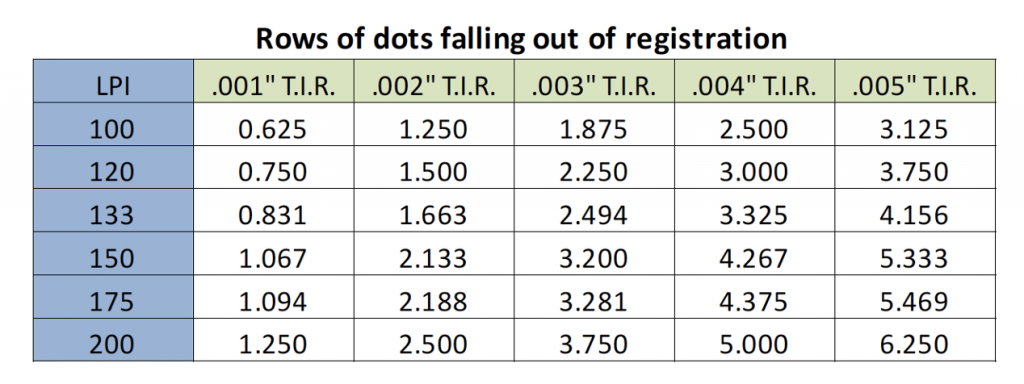A Bent Journal Translates to Poor Registration

The above statement is what many of us simplify that TIR has an adverse effect on print registration. However, many of today's flexographic printing presses don't even use print cylinders with journals. TIR can be the root cause of different print defects based on where that compromised surface is located. A bent anilox journal can cause an uneven ink delivery to the print cylinder or print sleeve and appears in the printed product as variable dot gain. In addition to uneven ink delivery, TIR at the anilox can also result in slur or elongation of dots. But focus does not stop at the print cylinder and anilox. TIR can be found in sleeve mandrels, impression rolls/drums, and even the drive shafts of rotational print station motors.
Is Runout the same as T.I.R.?
Runout is similar in concept to TIR but applies only to a specified location or locations, and not the entire rotating surface. The minimum or maximum value at each location is treated independently of all other locations. Keep in mind, there may be more than one location on a given press component that will have an effect on registration and overall print quality. Multiple locations of runout can compound the severity of the print defect(s).
Beyond Just Registration
Specifying TIR or runout tolerances will establish the boundary by which the parts will properly function for their designed use and life-cycle. When central axes of the 2 parts are offset directionally, angularly, or a combination of the two, the result can be lead to excessive stress on press components, experience premature wear, and potential failure of the part or press. The most common failure is caused by heat, created by friction when components do not meet their properly specified tolerances.
In printing, total indicator reading (TIR) is also known by the newer name "full indicator movement" (FIM). FIM is the difference between the maximum and minimum measurements, that is, readings of an indicator, on the planar, cylindrical, or contoured surface of a part, showing its amount of deviation from flatness, roundness (circularity), cylindricity, concentricity with other cylindrical features, or similar conditions. The indicator traditionally would be a dial indicator.
Example: For every .001” (.0254 mm) TIR change to the radius of the print cylinder or print sleeve, the print repeat is affected by .00625” (.15875 mm). This means for every.001” T.I.R. 3/4 of a row of dots could fall out of registration at 120 lpi.

Who Measures and When do We Measure?
Where TIR issues pertaining to drive shafts, impression drums, and runout in bearings or bushings are often identified by Maintenance personnel, often the most problematic areas can be caught by plate mounting and press crews. Mounting personnel are in an ideal position to measure TIR/run out of the print cylinder or sleeve. A simple magnetic base dial indicator can be attached to the mounter to measure plate cylinder journals at the outermost position and the concentricity of the cylinder or sleeve face. Most importantly, the cylinder is checked prior to wasting valuable mounting or press time. Press crews or prep personnel should check anilox journals prior to placing the roll into the press. Another great time to check the anilox is when the anilox is cleaned and/or measured to verify volume (BCM).
If you want to learn more about this subject, please feel free to reach out to us by calling 1-800-445-4017, or by e-mail at [email protected].
All Printing Resources has formed our Technical Solutions Group (TSG) to encompass our full range of expertise in all critical areas of the flexo process. This team is made up of industry professionals dedicated to being up-to-date on new technologies along with best practices. They are armed with the latest in diagnostic tools and are experienced in problem-solving that can achieve sustainable results. The TSG has walked in your shoes, and have felt your pain.
